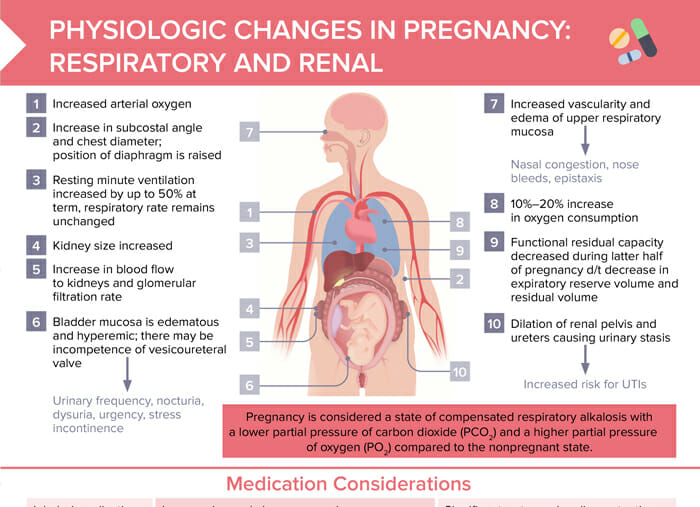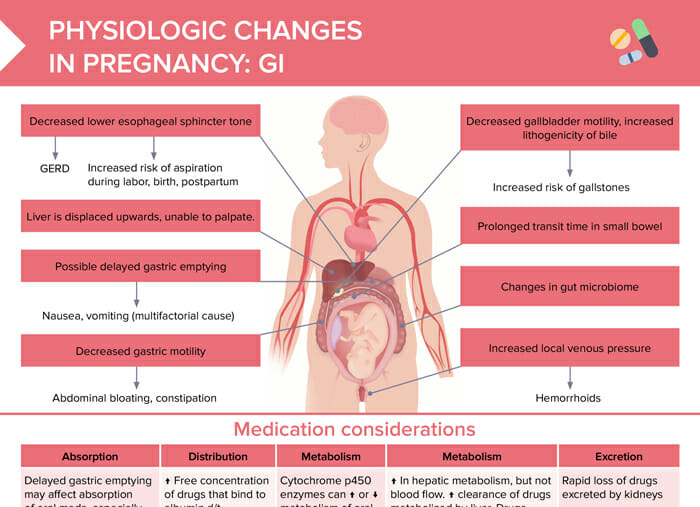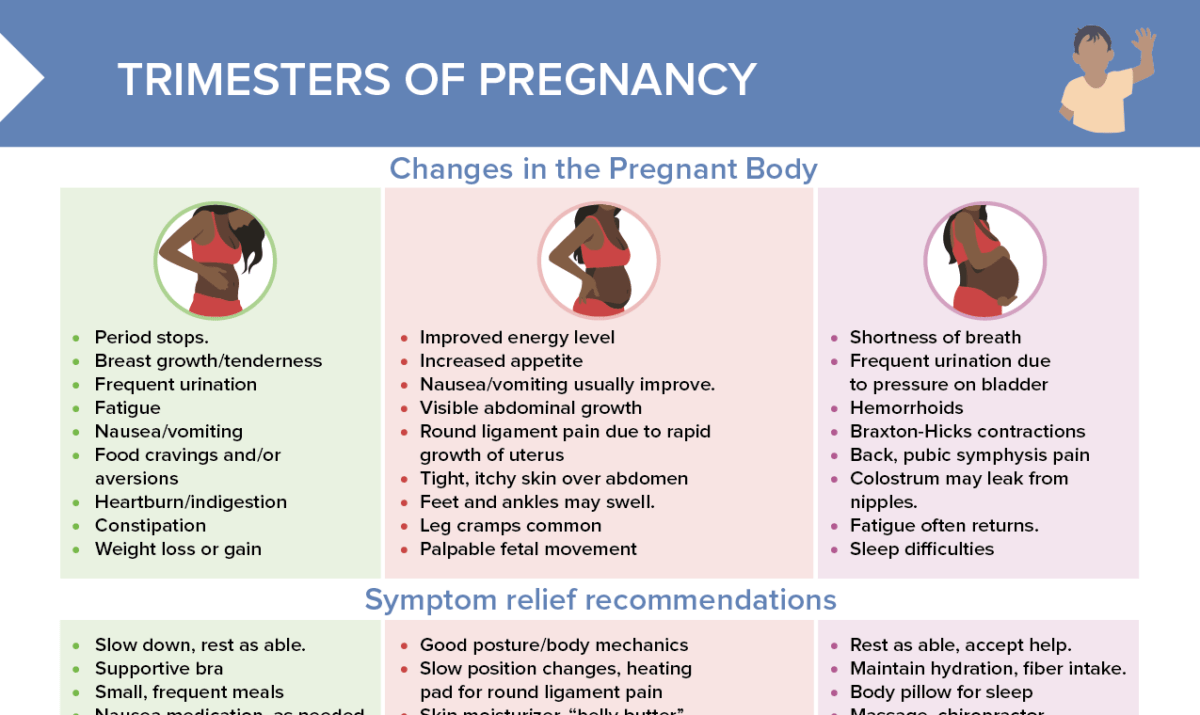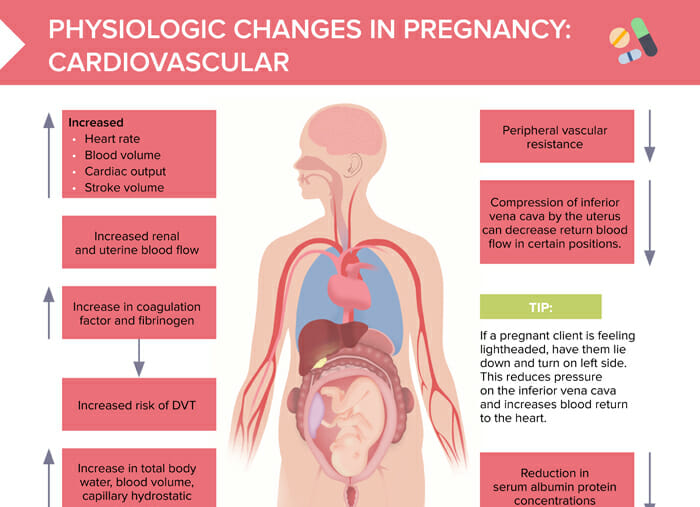Respiratory and renal changes in pregnancy
- Arterial oxygen is increased
- Increase in subcostal angle and chest diameter; position of diaphragm is raised
- Increased kidney size
- Resting minute ventilation increased by up to 50% at term (respiratory rate remains unchanged)
- Increase in blood flow to kidneys and glomerular filtration rate
- Bladder mucosa is edematous and hyperemic; there may be incompetence of vesicoureteral valve (→ urinary frequency, nocturia, dysuria, urgency, stress incontinence)
- Increased vascularity and edema of upper respiratory mucosa (→ nasal congestion, nose bleeds, epistaxis)
- 10–20% increase in oxygen consumption
- Functional residual capacity decreased during latter half of pregnancy d/t decrease in expiratory reserve volume and residual volume
- Dilation of renal pelvis and ureters causing urinary stasis (-→increased risk for UTIs)
Tip: Pregnancy is considered a state of compensated respiratory alkalosis with a lower partial pressure of carbon dioxide (PCO2) and a higher partial pressure of oxygen (PO2) compared to the nonpregnant state.
During pregnancy, 30 minutes of moderate-intensity aerobic activity is recommended ≥ 5 days a week to support respiratory health.
Pregnant clients are at higher risk of severe illness from respiratory disease than non-pregnant clients. Recommend vaccines per guidelines.

Free download: Renal and respiratory changes in pregnancy
Overview of respiratory and renal changes during pregnancy, effect on medications, and client education
GI changes in pregnancy
- Decreased lower esophageal sphincter tone (→ GERD, increased risk of aspiration during labor, birth, postpartum)
- Liver is displaced upwards, unable to palpate
- Possible delayed gastric emptying (→ nausea, vomiting)
- Decreased gastric motility (→ bloating, constipation)
- Decreased gallbladder motility
- Increased lithogenicity of bile
- Prolonged transit time in small bowel
- Changes in gut microbiome
- Increased local venous pressure (→ hemorrhoids)
Client education points
- Avoid supine position after eating to help prevent GERD.
- Eat smaller, more frequent meals and avoid an empty stomach to help w/ nausea/vomiting.
- Adequate fiber and water intake can help prevent constipation.
- Consult your provider before starting any over-the-counter treatments for GI symptoms.
When consultation is needed
Most GI conditions can be managed with supportive care and resolve after delivery. Conditions that require consultation:
- Gallstone pancreatitis
- Cholelithiasis with cholecystitis
- Acute hepatitis
- Intractable nausea/vomiting
- Severe dyspepsia
- Worsening irritable bowel disease
- Rectal bleeding in absence of hemorrhoids

Free download: GI changes in pregnancy
Overview of GI changes during pregnancy, effect on medications, client education, and examples of when consultations are required
Cardiovascular changes in pregnancy
Tip: If a pregnant client is feeling lightheaded, instruct the client to lie down and turn onto the left side. This reduces pressure on the inferior vena cava and increases blood return to the heart.
Increase in:
- Heart rate
- Blood volume
- Cardiac output
- Stroke volume
- Renal and uterine blood flow
- Coagulation factor and fibrinogen (→ increased risk of DVT)
- Total body water/blood volume/capillary hydrostatic pressure (→ forces fluid out of capillaries → swelling)
Decrease in:
- Peripheral vascular resistance
- Return blood flow in certain positions (due to compression of inferior vena cava by the uterus)
- Serum albumin protein concentrations (→ less ability to hold fluid in capillaries → swelling)
Medication considerations during pregnancy
Special considerations related to respiratory and renal changes
- Inhaled medications may be more readily absorbed.
- Increase in renal clearance can increase elimination rates of renally cleared medications, leading to shorter half lives (e.g., lithium, ampicillin, cefuroxime, cephradine, cefazolin, piperacillin, atenolol, digoxin)
- Significant water and sodium retention during pregnancy leads to hemodilution. This causes reduced peak serum concentrations of hydrophilic drugs.
Special considerations related to GI changes
- Absorption:
- Delayed gastric emptying may affect absorption of oral meds, especially during labor.
- IM meds are not affected.
- Distribution: ↑ free concentration of drugs that bind to albumin d/t hemodilution
- Metabolism:
- Cytochrome p450 enzymes can ↑ or ↓ metabolism of oral drugs in the liver during pregnancy.
- ↑ In hepatic metabolism, but not blood flow
- ↑ Clearance of drugs metabolized by liver
- Drugs that depend on delivery to the liver (blood flow) are unaltered.
- Excretion: rapid loss of drugs excreted by kidneys
Special considerations related to cardiovascular changes
- Due to increased total body water, hydrophilic drugs may require higher initial and maintenance doses.
- There can be an increased amount of unbound (active) drugs in pregnant clients due to lower serum protein levels.
Permanent body changes after pregnancy
Most physiologic pregnancy changes are temporary. Pregnancy-induced physiologic changes to respiratory and renal systems should return to non-pregnant state by 4–6 weeks postpartum. GI changes often resolve after delivery (with some exceptions like hemorrhoids or GI muscle tone). Cardiovascular changes immediately begin to reverse with delivery and return to pre-pregnancy levels quickly, with the possible exception of cardiac remodeling that has happened during pregnancy which can take a few months to return to previous state.
Some changes that come with pregnancy can be long-lasting or permanent. Examples of more common permanent changes include:
- Breast changes (different size and shape)
- Foot size (may remain increased)
- Stretch marks and varicose veins
- Abdominal changes (e.g. diastasis recti, a persistent separation of the abdominal muscles)
- Skin changes (e.g. melasma or linea nigra that may fade but not completely disappear)
- Weight (may be difficult to return to previous body composition even with diet and exercise)

